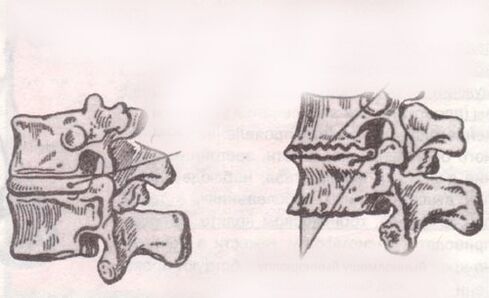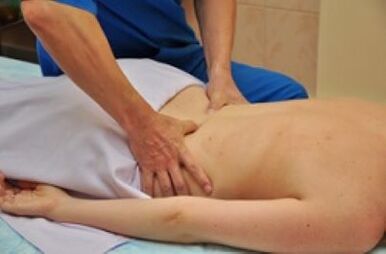Lumbosacral spine osteochondrosis is a dystrophic spinal disease, in which the normal structure of the entire spinal column and intervertebral discs is gradually destroyed.It should be said that not only the back suffers, but the whole organism, especially the pelvic organs and the lower limbs.

The reasons for the development
The lumbar region for a person's life in relation to a justice experiences a colossal vertical load that cannot fully compensate for the large size of the vertebrae.Therefore, the smallest shifts in the human body, a decrease in lower back muscle corsets, excess weight, damage, incorrect movements and much more can lead to the development of the disease.Also, you should always remember about age -related changes in the back about each person.

Summarizing the above, the most common risk factors can be distinguished, the whole of which leads to Lumbar osteochondrosis:
- Uneven and irregular loads on the back (the severity of rising from a prone position, etc.).
- Excess weight (almost every kilo is important).
- Fraud injections, including sports.
- Weakening of muscle lanes (prolonged work in a monotonous position, etc.).
- Endless diet, weak in minerals and vitamins.
Symptoms
Symptoms of the disease can vary widely, however, the totality of the main signs of osteochondrosis develops, as a rule, in three syndrome:
- Vertobroogen lumbalgia (lumbago synonym).
- Vertro -Karbon Lumboyshialgia.
- Ischialgia vertro -karbon (inflammation of the sciatica).
However, in addition to pain in the lumbar region (with radiation in the legs, gluteal, inguinal areas of or without such), lower back muscle tension, weakness in the foot, crisis during back movements and difficulties in the lumbar region should be distinguished by a number of other important osteochondrosis symptoms:
- The sharpness of the legs and a feeling of crawling on the foot.
- Stalemate on foot.
- Disordishes pelvic disorders (delay or incontinence of urine, constipation or diarrhea).
- Weakness in certain groups of the leg muscles.
These complaints may orient the neurologist at the level of spinal cord injury, make a differential diagnosis with other spinal diseases.
Diagnosis and signs of X -rays

Osteochondrosis should be diagnosed with only one type of instrumental method - radiological.Visualize the entire spine structure in modern medicine allows the best study of MSCT or MRI, however, simple radiography has not lost its estimated value (as a review study).It is important to remember that the main stage of diagnosing problems with the spine will be a medical examination, which sometimes allows you to make a diagnosis without examination at all.
In the neurological status, pain is detected on palpation of the spicy processses of vertebrae, tension of the Lower Back Muscles, and if there is only osteochondrosis;Compression of the Spinal Cord Roots), IMPIED MUSCLE AND MUSCLE OF THE LEGS, Weakness of Movement of Movement of Motion in the Foot.In the presence of these symptoms, differential diagnosis with disc herniation and other, more serious spinal cord disease should be performed.
Treatment
The treatment of the disease involves prolonged complete therapy.Guidelines in the treatment of some - removal of irritation medicines, non -Drug auxiliary methods, as well as preventive method of physiotherapy exercises, partially used in the acute period, and do not lose its importance to this day.
potion
It is a combination of myoorlaxing therapy, anti -inflammatory pathogenetic therapy, as well as the use of neuroprotective drugs.The choice of drugs and dose calculations derive from a person's weight, gender, presence of simultaneous diseases.
In the acute period, it is advisable to inject medicines such as diclofenac, meloxicam.Also, in parallel, they begin to perform therapy for removing muscle spasm and protecting the nerve fiber from damage.
Jod

It is represented by physics and manual impacts.Given the mass of muscle groups, a fairly wide level of the anatomical area, physiotization can only be an auxiliary method.DDT, electrophoresis, magnetotherapy are used, which allow you to improve the effect of medication.
However, massage and manual therapy are sometimes able to completely stop the symptoms of lumbar osteochondrosis without even support for medicines.This is due to the fact that muscle spasms can be removed quite well, and the pain is not always provoked by the inflammatory process, sometimes only careless movement leads to pain, the consequences of which are effectively eliminated in the early hours after the development of pain.
Gymnastics for the osteochondrosis of the lumbar region aims to stretch the back muscles and strengthen them.In the presence of established diagnosis, lumbar osteochondrosis should be engaged daily in physiotherapy exercises.Depending on the general rules (limiting excessive physical activity, hypothermia), body weight control and exercise for lumbar region osteochondrosis for the disease can sometimes be forgotten for many years.
























